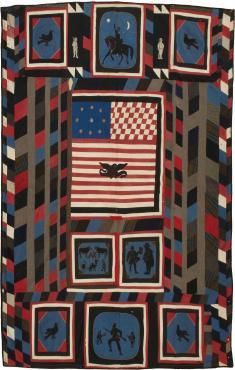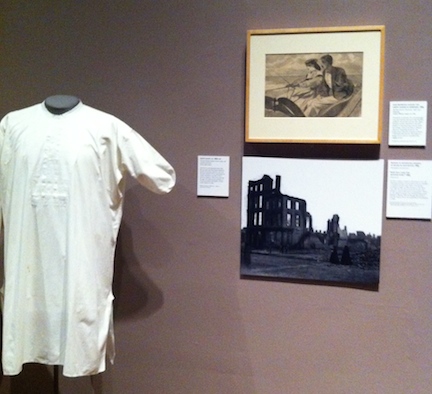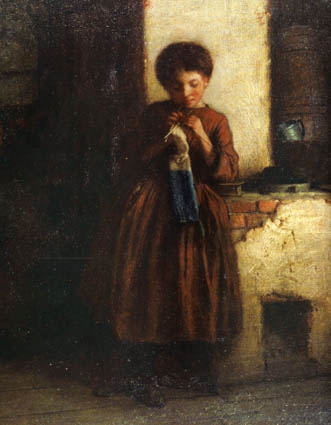One of the first items you see in the New-York Historical Society’s exhibition on Civil War textiles is a giant cotton bale. Its burlap bagging is shredded so that the cotton mushrooms up out of it, released from the tension of compaction. Behind it is a photograph of a Confederate fortification at Yorktown in 1862, built out of dirt, sticks, and bales like this one; to its left is a deep basket, filled with loose cotton bolls.
This initial set piece conveys the central argument of the exhibit: that we can access the causes and the experiences of the Civil War through the things that people cultivated, sold, bought, made, wore, carried, used, and sent home between 1861 and 1865. These things—especially textiles—“linked rich and poor, slave and free, agriculture and industry,” soldiers and civilians, and men and women during wartime.

There are fascinating objects here. You see quilts and handkerchiefs (many of them printed or stamped with text), cloth worn by slaves and produced by them, a hemp rope and noose (which allegedly hanged John Brown), banners and flags, canvas tenting and knapsacks. You learn the history of the term “shoddy.” You fear that there will be some fetishizing of uniforms, but there is not.
The exhibit is organized chronologically but there is no timeline provided, nor is there abundant historical information in the panels or labels. This is not really surprising; the exhibit is not meant to be an exhaustive explication of the war itself. A deeper knowledge of wartime events is useful for understanding the significance of some items (the flag of truce from Vicksburg, for example) but surrounding objects (broadsides, illustrations from Harper’s Weekly, photographs) contextualize others without over-explanation.

There are some moments of randomness: a wall devoted to contrabands seems to have no argumentative connection to textiles, while a handkerchief printed with mileage charts between towns is beautiful but seems disconnected from the items next to it.
And a potential showstopper gets lost in the mix: Eastman Johnson’s painting Knitting for the Soldiers (1861)—a little known but lovely gem—hangs unobtrusively on a wall crowded with reproductions of illustrations, photographs, and other objects.
It deserves a wall of its own, I think—or at least a little more breathing room.

Overall, “Homefront and Battlefield: Quilts and Context in the Civil War” (which is actually about more than just quilts) tells important stories about industrialization and wartime production, about the role of cotton in bringing about the war, and enabling it to continue. It also tells more intimate tales, about men sitting in front of their tents patching their socks, women stabbing needles into silk with barely suppressed rage, and families preserving whatever scraps of fabric they could, keeping a record of the material realities of war.
“Homefront and Battlefield: Quilts and Context in the Civil War,” a traveling exhibition organized by the American Textile History Museum in Lowell, Mass., is showing at the New-York Historical Society through August 24, 2014.
Oh wait, that’s what the t-shirt thing is? Unbelievable!
Sounds like a fascinating exhibit. What was your favorite item–the painting? What favorite physical piece? I’m hoping to trick you into describing more things because you do it so well.
Ha! No tricks required. I really did love Johnson’s image–I had never seen it before, and it is quite unusual for a wartime painting: a luminous domestic scene with a child (and a textile!) at the center. As for the fabrics, I was drawn more to the soldiers’ items than to the quilts–I think because Civil War historians so rarely think about the material worlds of soldiers. And there was the amputee’s shirt, of course. My friends and I had a conversation about whether or not the shirt had been made-to-order, or whether someone had taken off the whole left sleeve, cut and re-sewed it, and then reattached it to the shirt. If the latter, we can see it as another kind of amputation …